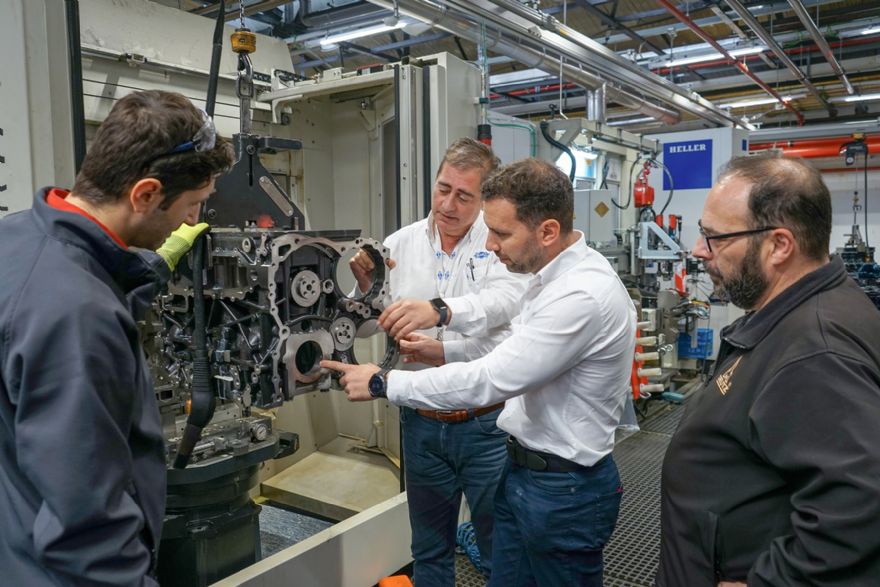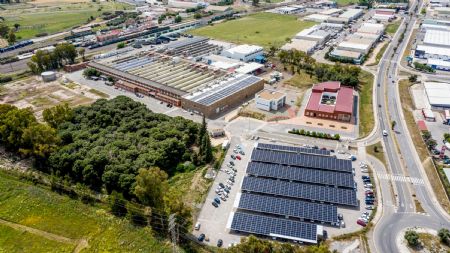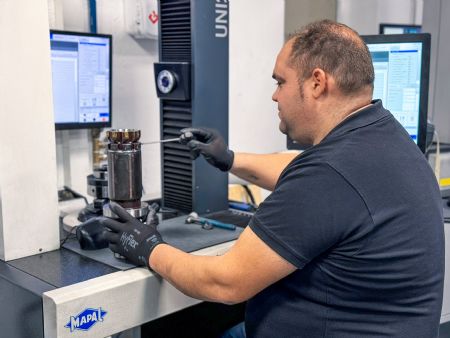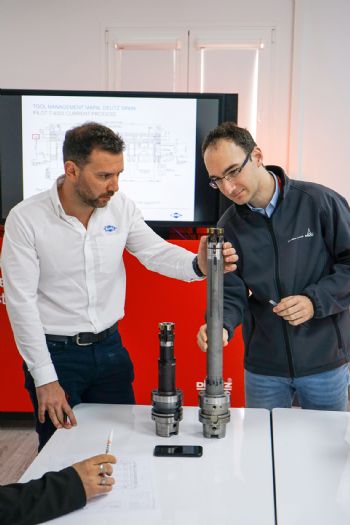
Engines were already being built in 1875 at the site in Zafra Spain, where
Deutz today has its main factory for manufacturing engine components — the factory is a key part of Deutz’s global operations. Engine blocks, cylinder blocks, connecting rods and gears are produced here by around 500 employees in modern manufacturing facilities for the company’s German assembly lines in Cologne and Ulm as well as for other customers.
Deutz’s latest future-proofed 3.9-litre diesel engine will mostly be used in agricultural and construction machines. As an industrial engine, it is designed to have a long service life and will be built at the site until at least 2035 — series production is to start in the coming year after its current prototype phase has been completed. This engine, which will be available in a power range from 55 to 160kW, represents an important future project for Deutz. As it is the same size as its 3.6-litre predecessor, it can be installed in the same vehicles where it will provide extremely efficient performance — the company is ramping up to produce 50,000 units each year.
Alejandro Castilla De La Hoya, Zafra plant manager, said: “Our engines are typically deployed in off-highway applications like agricultural and construction machines, which are in constant use and move heavy loads. We will continue to need internal combustion engine to move those machines. For the time being, it will be in the form that we use today: the diesel engine. Synthetic fuels or hydrogen can considerably prolong their deployment.”

He pointed out that the income from this area helps to finance Deutz’s investments in the ‘green’ segment, which is dedicated to mobility transformation. The 3.9-litre diesel engine is designed to run on gas or hydrogen in the future.
Manuel Rodríguez López, industrialisation manager, said: “Based on today’s design, this diesel engine can become a ‘green’ engine in the long run.” This is possible thanks to a package of small modifications, particularly to the cylinder head. Otherwise, the engine remains mostly the same otherwise. Mapal has already begun collaborating on Deutz’s first 7.8 litre hydrogen engine.
Thomas Spang, global head of tool management at Mapal, said: “Our clients’ development periods for new parts are becoming shorter and shorter.” For tool manufacturers or complete suppliers like Mapal, this represents a growing challenge, especially if plans change at the last minute, while the deadline for the tool design remains the same. For example, in the case of the engine block of the new 3.9-litre diesel engine, Mapal only had two weeks after the engine design was completed to come forward with a final offer.
Well-tuned workflowsAn ardent team of experts in Aalen were able to complete this ambitious task on time. Well-tuned workflows proved advantageous for the team as did the many years of experience with the client’s production methods. Mapal has been conducting tool management for Deutz in Spain for 18 years. Several projects have been completed together over the years.
Mapal already engineered the machining of the engine blocks for the predecessor 3.6-litre diesel engine, which meant it was able to draw on practical experience and didn’t have to start from scratch. For example, the tooling supplier already knew which machines the engine manufacturer has from previous projects. Deutz has equipped its assembly line in Zafra with new five-axis machines over recent years, to ensure it has the flexibility to switch to new products with relative ease.

When Deutz sent its request, the tool management department at Mapal in collaboration with the company‘s technology expert team (TET) in Aalen first gave some thought to the production process. Harald Traub from TET, said: “We don’t concern ourselves with detail at this early stage, but instead pull together reference tools and concepts from previously completed projects.” Responsible for planning the entire process as project egineer, he said: “In this way, we are able to specify an approximate budget and the rough scope of the tool package for the client.”
After this rough planning, the final tool design followed in the second week. Mapal’s offer for the series production of the motor block included almost 100 different tools in the end. Many of them are custom tools that achieve short machining time and high economic efficiency. Aside from these, standard tools are used for milling.
To produce prototypes quickly, a few close-to-standard tools were also utilised. Series production can then quickly begin with the optimal set of tools. As part of the original delivery, Mapal supplied consumable tools as well as the required tool holders and adapters to Deutz. All other consumables are then handled by the tool management on site, and from this point on, the client no longer pays per tool but per completed part.
The unit costs at first correspond to the price determined during engineering. Certain ratios are then agreed for the following years. The client receives an increasing percentage of rebate and therefore pays a bit less per unit every year. For this business model to work out, Mapal has to implement continual improvements to save costs. This is done with new tool technologies and corresponding optimisation. The costs per part are fixed over the term of the contract, after which a reassessment takes place. Such contracts, which run over four to five years, are ideal for clients as they offer planning security.

Mr Spang added: “With our engineering expertise, we support Deutz beyond the tool-setting area and cultivate a close partnership,” After helping to build the prototype, it is the tool management’s turn to shine on-site during series production. Deutz uses approximately 1,300 different tools in total. Thousands of tools are available from stock and have to be managed in Zafra. To keep inventory at an optimal level, to avoid bottlenecks while also preventing unnecessarily high tool stocks, Mapal uses its own warehouse management systems and digital solutions with the cloud-based software c-Com for tool management. The digital Tool Management 4.0 doesn’t only handle procurement processes, which are initiated semi-automatically, it also acts as a reporting tool to analyse cost drivers and stocks.
Deutz’s industrialisation manager Manuel Rodríguez López praised the good collaboration with Mapal when it comes to tool management. He said: “Over the course of our cooperation, we have developed extensive technological concepts, which go far beyond mere logistics. Besides achieving cost reductions, tool setting is particularly important for us. The Mapal employees working on-site have a lot of know-how and ensure that production has exactly the tool they need at the right time.”
Mapal’s tool manager on-site is David Castaño. Mapal also employs tool setters permanently in Zafra. They make sure that a dozen different parts are produced without a hitch. Manuel Padilla Fernández, manufacturing engineering manager at Deutz, who works closely with Mapal’s tool manager David Castaño, said: “It is very beneficial to have David available on-site. We can talk about any opportunities for optimisation directly at the machine. We don’t consider David to be an external service provider but rather an integral part of our team — we have a very strong cooperation.”
If required, new tool solutions can be developed in Aalen via the local Mapal team. That was the case in Zafra when it became necessary to optimise the tools for machining the bore in the crankshaft and camshaft. In cooperation with Deutz, a new machining concept from Mapal with its HPR400 reamer was implemented. Mr Castaño is convinced of its advantages. He concluded: “The tool life of the previous tool was 350 units and resetting was required every 100 units. With the HPR400, we achieve a tool life of 1,000 parts without resetting. The resulting machining quality is exceptionally good.”